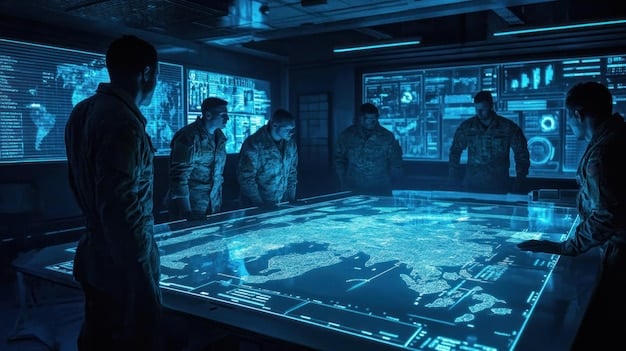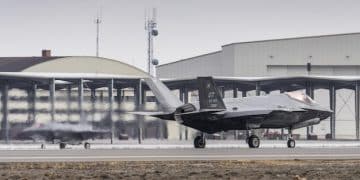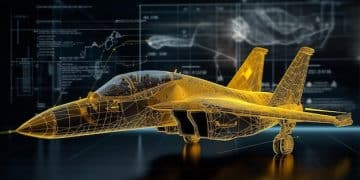Defense Industry Outlook: Key Trends for US Market in Next 12 Months

The Defense Industry Outlook: Key Trends and Predictions for the Next 12 Months in the US Market is characterized by geopolitical shifts, technological innovation, and evolving procurement strategies, necessitating agile adaptation from defense contractors and policymakers to maintain strategic advantage and address emerging global threats effectively.
The global geopolitical landscape is in constant flux, and its ripples are felt most acutely within the defense sector. As we look ahead, the Defense Industry Outlook: Key Trends and Predictions for the Next 12 Months in the US Market suggests a period defined by accelerated technological integration, strategic recalibration, and a relentless pursuit of advanced capabilities. This deep dive aims to dissect the forces shaping the US defense industry, offering insights into what stakeholders can expect over the coming year.
Geopolitical Shifts and Budgetary Pressures
The US defense industry operates within a complex web of global events and domestic political realities. Mounting tensions in Eastern Europe, ongoing strategic competition in the Indo-Pacific, and volatile regions across the Middle East continue to drive demand for robust military capabilities. These external pressures directly influence budgetary allocations and strategic priorities, pushing for investment in specific areas.
Simultaneously, domestic economic considerations and political debates surrounding national debt and spending priorities inevitably place budgetary pressures on the Department of Defense (DoD). This creates a challenging environment where efficiency, cost-effectiveness, and maximum return on investment become paramount.
Navigating Global Volatility and Strategic Priorities
In response to evolving threats, the US defense strategy emphasizes readiness, deterrence, and capability development across multiple domains. This means not only maintaining superiority in traditional warfare but also expanding into new frontiers like cyber and space. The next 12 months will see continued emphasis on these strategic priorities, with funding directed towards initiatives that enhance global responsiveness and technological edge.
- Renewed focus on near-peer competition, particularly with China and Russia.
- Increased investment in strategic deterrence capabilities.
- Emphasis on multi-domain operations and joint force integration.
- Strengthening alliances and partnerships to counter shared threats.
The interplay between these geopolitical imperatives and budgetary realities demands innovative approaches from defense contractors. Companies must demonstrate value, deliver cutting-edge solutions, and prove their ability to adapt to rapidly changing requirements. Expect a continued push for modularity and open-architecture systems to allow for quicker upgrades and integration.
Furthermore, the US defense budget, while substantial, is always subject to political negotiation and evolving national priorities. This environment compels defense companies to not only innovate technologically but also to be strategic in their lobbying efforts and transparent in their cost structures to secure contracts.
Advanced Technology Integration: AI, Hypersonics, and Quantum Computing
The future of warfare is intrinsically linked to technological superiority. The next 12 months will witness an accelerated integration of artificial intelligence (AI), hypersonics, and quantum computing into various aspects of defense, from intelligence gathering to combat operations. These technologies promise to redefine military capabilities and operational doctrines.
AI, for instance, is no longer a futuristic concept but a vital tool for enhancing decision-making, optimizing logistics, and improving the accuracy of autonomous systems. Hypersonic weapons, with their unparalleled speed and maneuverability, are poised to challenge existing defense paradigms. Quantum computing, while still in nascent stages for defense applications, holds the potential to revolutionize cryptography, sensor technology, and complex problem-solving.
The Rise of AI and Machine Learning in Defense
Artificial intelligence and machine learning (ML) are becoming indispensable across the defense spectrum. Their applications range from predictive maintenance for equipment to advanced target recognition and sophisticated cyber defense systems. The DoD is actively pursuing initiatives to leverage AI to gain a decisive operational advantage.
- Enhanced data analysis for intelligence and surveillance.
- Autonomous systems for reconnaissance and combat support.
- AI-driven cybersecurity and threat detection.
- Predictive logistics and supply chain optimization.
Investment in these AI capabilities will continue to surge as the US aims to maintain its technological edge over adversaries. This also creates a competitive landscape among defense contractors, who are racing to develop and integrate the most effective AI solutions. Ethical considerations and responsible development of AI in warfare will also remain a critical discussion point.
Hypersonic Capabilities: A New Era of Speed and Strike
The development and deployment of hypersonic weapons represent a significant shift in military strategy. These weapons, capable of traveling at speeds greater than Mach 5, present formidable challenges to existing missile defense systems. The US is focused on both developing its own hypersonic arsenal and developing countermeasures against potential adversaries’ capabilities.
The next year will see continued testing, refinement, and initial deployment of hypersonic systems, pushing the boundaries of conventional warfare. This push is fueled by a desire to ensure prompt global strike capabilities and deter aggression. The R&D efforts in this domain are intense, involving complex material science, propulsion systems, and guidance technologies.

Supply Chain Resilience and Domestic Manufacturing
The fragility of global supply chains, starkly highlighted by recent world events, has prompted a significant re-evaluation within the defense sector. Dependence on foreign sources for critical components, raw materials, and specialized manufacturing processes poses national security risks. Consequently, there is an intensified focus on bolstering domestic manufacturing capabilities and ensuring robust supply chain resilience.
This includes efforts to onshore production, diversify suppliers, and invest in advanced manufacturing technologies within the United States. The goal is to reduce vulnerabilities, enhance responsiveness to surges in demand, and safeguard proprietary defense technologies from potential intellectual property theft or compromise.
Rebuilding Domestic Manufacturing Bases
The drive to rebuild and strengthen domestic manufacturing is a multifaceted effort. It involves government incentives, partnerships with private industry, and educational initiatives to develop a skilled workforce. The aim is to ensure that the US has the capacity to produce essential defense-related goods and services without undue reliance on external entities.
- Government-funded initiatives to onshore critical production.
- Increased R&D investment in advanced manufacturing techniques.
- Programs to train and educate a specialized defense manufacturing workforce.
- Incentives for defense contractors to prioritize domestic sourcing.
This strategic shift is not merely about economics; it’s about national security. By securing key supply chains, the US can better respond to crises, maintain a technological edge, and protect its sensitive defense capabilities from external interference. This will inevitably lead to new opportunities for US-based manufacturers and tech companies.
The challenge lies in balancing cost-effectiveness with security. While domestic production may sometimes be more expensive, the long-term strategic benefits often outweigh the immediate financial considerations. Expect closer scrutiny of international partnerships and renewed emphasis on “Made in America” policies within the defense procurement process.
Cybersecurity Threats and Digital Transformation
In an increasingly interconnected world, cyber warfare has emerged as a critical domain of conflict. The US defense industry faces persistent and evolving cybersecurity threats from state-sponsored actors, sophisticated criminal organizations, and hacktivist groups. Protecting sensitive data, critical infrastructure, and advanced weapon systems from cyber intrusions is paramount.
Consequently, digital transformation within the defense sector is not merely about efficiency; it’s a strategic imperative. This involves not only upgrading existing IT infrastructure but also embedding cybersecurity protocols into every stage of system design, development, and deployment. The next 12 months will see heightened investment in advanced cyber defenses and a more integrated approach to digital security.
Fortifying Defenses in the Digital Battlefield
The scope of cybersecurity in defense extends far beyond traditional network protection. It encompasses securing the supply chain, protecting intellectual property, ensuring the integrity of weapon systems, and preparing for sophisticated cyber-attacks that could cripple critical national assets. The DoD is embracing a proactive, rather than reactive, cybersecurity posture.
- Development of next-generation encryption technologies.
- Enhancement of threat intelligence and predictive analytics capabilities.
- Rigorous cybersecurity testing for all new defense systems.
- Training and recruitment of a highly skilled cyber workforce.
The integration of artificial intelligence and machine learning into cybersecurity frameworks is rapidly advancing, allowing for faster detection and response to anomalies. Zero-trust architectures are becoming a standard, ensuring that no user or device is inherently trusted, regardless of their location within the network perimeter. This comprehensive approach is essential for maintaining superiority in the digital battlespace.
Furthermore, the collaboration between government, industry, and academia in sharing threat intelligence and developing common defense standards will intensify. The shared understanding of adversaries’ tactics, techniques, and procedures (TTPs) is crucial for building resilient and adaptive cyber defenses capable of withstanding persistent attacks.

Sustainability and Environmental Considerations
While often associated with heavy machinery and energy consumption, the defense industry is increasingly recognizing the importance of sustainability and environmental responsibility. This focus is driven by a combination of factors, including regulatory pressures, public perception, and the strategic advantages of reducing reliance on fossil fuels and mitigating environmental impact.
The next 12 months will see a greater emphasis on developing and adopting greener technologies, optimizing energy efficiency in military operations, and incorporating sustainable practices throughout the defense supply chain. This transition also aligns with broader national efforts to address climate change and promote a more sustainable future.
Green Technologies and Energy Efficiency in Defense
From alternative fuels for military vehicles to renewable energy sources for forward operating bases, the pursuit of greener defense solutions is gaining momentum. Reducing carbon footprints and improving energy independence are not just environmental goals; they also offer significant operational benefits, such as decreased logistical burdens and enhanced resilience.
- Investment in electric and hybrid military vehicles.
- Deployment of solar and wind power at military installations.
- Research into sustainable aviation fuels and advanced battery technologies.
- Waste reduction and recycling initiatives across the defense enterprise.
Defense contractors are actively exploring innovative materials and manufacturing processes that minimize environmental impact without compromising performance or safety. This includes lifecycle assessments of products and systems, aiming for sustainability from conception to decommissioning. The integration of these practices is becoming a key differentiator in contract bidding.
Moreover, the US military is a massive consumer of energy, and even modest improvements in efficiency can lead to substantial financial savings and strategic advantages. The adaptability of renewable energy solutions in diverse operational environments also makes them attractive for enhancing battlefield resilience and reducing logistical vulnerabilities.
Commercial Partnerships and Collaborative Innovation
The traditional boundaries between the defense sector and the commercial technology landscape are rapidly blurring. Recognizing that much of the cutting-edge innovation now originates in the commercial sphere, the US defense industry is increasingly fostering partnerships and collaborations with non-traditional defense contractors, particularly startups and tech giants. This shift is crucial for rapidly acquiring and integrating advanced capabilities.
These partnerships aim to leverage commercial off-the-shelf (COTS) technologies, accelerate research and development cycles, and tap into a broader talent pool. The next 12 months will see a continued push towards more agile procurement processes and innovative funding mechanisms designed to facilitate these collaborations and bring disruptive technologies to the warfighter faster.
Bridging the Gap Between Defense and Commercial Tech
Initiatives like the Defense Innovation Unit (DIU) are at the forefront of this effort, acting as a bridge between Silicon Valley and the Pentagon. These organizations aim to streamline the acquisition process, making it easier for commercial companies to navigate the complexities of defense contracting. The focus is on speed, scalability, and impact.
- Increased use of prototypes and rapid experimentation to evaluate commercial technologies.
- Flexible contracting mechanisms to attract non-traditional defense vendors.
- Emphasis on dual-use technologies that serve both commercial and military purposes.
- Creation of innovation hubs and incubators to foster collaboration.
This collaborative approach extends beyond technology acquisition to include talent development and knowledge sharing. By working closely with commercial partners, the defense industry can adopt best practices in areas like agile software development, artificial intelligence implementation, and big data analytics. This cross-pollination of ideas and expertise is vital for staying ahead of adversaries.
The challenge remains in scaling successful prototypes into deployable solutions within the strictures of military requirements and security protocols. However, the recognition that innovation doesn’t exclusively happen within traditional defense circles is driving a more open and collaborative ecosystem, leading to faster adoption of critical technologies.
| Key Trend | Brief Description |
|---|---|
| 🚀 Advanced Tech Integration | Rapid adoption of AI, hypersonics, and quantum computing to enhance military capabilities and operational efficiency. |
| 🛡️ Cybersecurity Fortification | Increased investment in sophisticated cyber defenses to protect critical infrastructure and weapon systems from evolving threats. |
| 🏭 Supply Chain Resilience | Focus on domestic manufacturing and diversification of suppliers to mitigate risks and ensure robust defense production. |
| 🤝 Commercial Partnerships | Growing collaboration with commercial tech companies and startups to accelerate innovation and integrate disruptive technologies. |
Frequently Asked Questions
The US defense industry is heavily influenced by rising tensions with near-peer competitors like China and Russia, ongoing conflicts in key regions, and global instability. These factors drive strategic investment in advanced capabilities and readiness, shaping procurement decisions and research priorities significantly over the next year.
Over the next year, AI will increasingly integrate into defense for enhancing data analysis, autonomous systems, predictive maintenance, and cybersecurity. This integration aims to improve decision-making, optimize logistics, and provide a significant operational advantage, pushing for rapid development and ethical deployment across the DoD.
Supply chain resilience is crucial due to past vulnerabilities to disruptions and over-reliance on foreign sources for critical components. The focus is now on onshoring production and diversifying suppliers to reduce national security risks, ensure manufacturing capacity, and safeguard proprietary technologies against external threats.
Commercial partnerships are vital for defense innovation, as much cutting-edge technology now originates outside traditional defense contractors. Collaborations with startups and tech giants allow the DoD to leverage COTS technologies, accelerate R&D cycles, and tap into broader talent pools, leading to faster integration of disruptive solutions.
Environmental considerations are increasingly impacting the defense industry through regulatory pressures and a drive for operational efficiency. This includes developing greener technologies, optimizing energy consumption, and adopting sustainable practices. These efforts aim to reduce fossil fuel dependence, mitigate environmental impact, and enhance long-term strategic resilience.
Conclusion
The Defense Industry Outlook: Key Trends and Predictions for the Next 12 Months in the US Market paints a picture of a sector undergoing profound transformation. Driven by an intricate interplay of geopolitical dynamics, technological accelerations, and strategic reassessments, the industry is poised for significant evolution. The emphasis on advanced technology, robust cybersecurity, and resilient supply chains underscores a commitment to maintaining a decisive military advantage. As defense contractors and policymakers navigate this complex environment, adaptability, innovation, and strategic partnerships will be paramount to meeting the challenges and securing the future of national defense.





